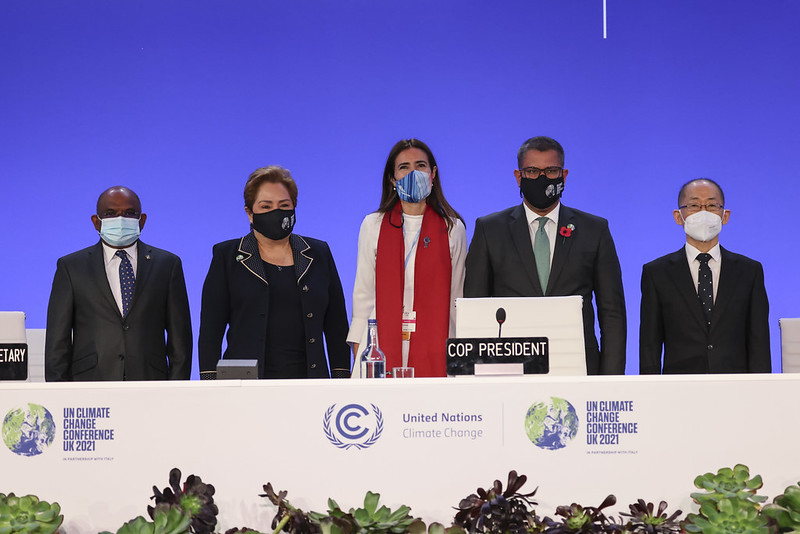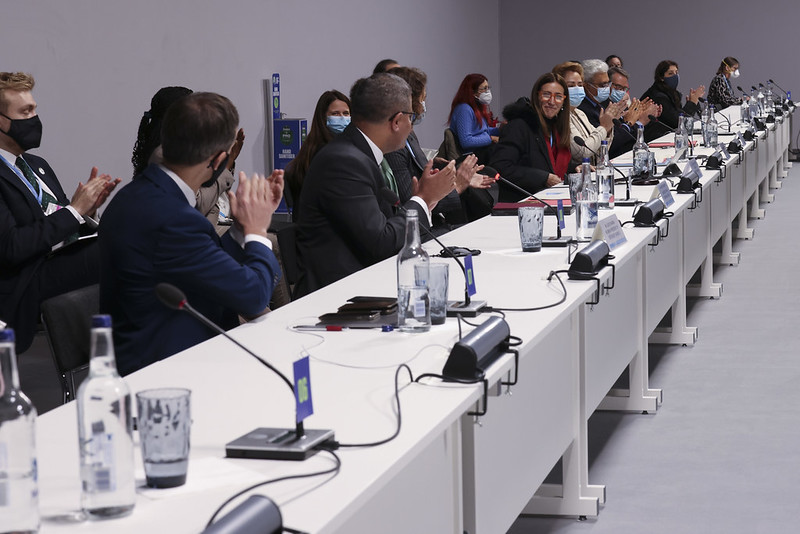Professor Lena Dominelli, Professor of Social Work, Faculty of Social Sciences, University of Stirling

Lena Dominelli is a COP veteran, having attended UN Climate Change Conferences for more than a decade. As negotiations get underway in Glasgow, Lena provides an honest account of what it’s like to play a part in a global environmental conference, the challenges to overcome, and her hopes for the Glasgow summit.
COP26: Why the UN Climate Change Conference matters
The excitement of being involved in witnessing a critical opportunity to stop the world hurtling into planetary oblivion through human refusal to take seriously tackling climate change is unavoidable. I have been attending COP (Conference of the Parties, i.e., government delegates) meetings on behalf of the International Association of Schools of Social Work (IASSW) since 2010. I was chosen for this task following my raising the invisibility of social work at such proceedings, organising a conference to raise social workers’ profile on the topic, and writing a policy document on climate change for IASSW at the COP meeting in Copenhagen in 2009. This COP was doing well until the then President Barak Obama waltzed into town, joined forces with China, and together convinced the COP delegates that the world had time to wait for action to reduce fossil fuel consumption. This action produced the ‘Copenhagen Flop’. This policy of delaying serious climate change action until tomorrow remains a thread in many national discourses about reaching net zero emissions for too many countries, especially the largest polluters. Under the Paris Accord in 2015, most countries, under the leadership of France and assisted by the USA, EU and China, agreed to aim for a 1.5˚C rise in temperature to avoid climate catastrophe. The IPCC (International Panel on Climate Change, a panel of scientific experts) advising the UNFCCC (United Nations Framework Convention on Climate Change, i.e., an agreement to address climate change) also warned that this objective had to be reached by 2030.
The primacy of national self-interest continues to reign, and the world’s largest polluters – China, the USA (especially under President Trump), and emerging economies such as India, Russia and others have ignored the IPCC’s cautionary note and produced National Action Plans that fall short of meeting this objective by 2030. According to some analysts, the world has already reached 1˚C of temperature rise since the beginning of the Industrial Revolution. Consequently, humanity is facing its biggest social crisis to date, which will see climate refugees go on the march to cooler lands. Such movements are predicted to run from 250 million to one billion people and will place considerable stress on the built infrastructures and service sectors of most receiving countries unless steps are taken to eliminate the ‘push’ factor called ‘climate change’. Unfortunately, the countries that will suffer the most will be those in the Global South that desperately need to rise out of poverty, and who have contributed least to climate change. These include 38 Small Island Developing States (SIDS) in the Caribbean and Pacific Ocean, low-lying countries like Bangladesh and most of sub-Saharan Africa, among others.
That COP26 is coming to Glasgow, a major centre of the Industrial Revolution, is fitting as it should propel the UK to raise ambitions among all participating countries, including those who have decided to stay away for COVID-19, and other reasons. They are all members of the UNFCCC and have committed themselves to tackling climate change. They simply need to move their clocks forward to meet ‘net zero’ targets for the 2030 deadline. Currently, key countries have set their dates as follows, Scotland -2045, England – 2050, China – 2060, India -2060 and Russia – 2060. Key to moving these deadlines to avoid planetary catastrophe is making available cheap renewable green energy available to everyone and transferring $100 billion per year to low income countries to redress historical wrongs, purchase renewable technologies, facilitate other mitigating initiatives such as building sea walls, and eliminate poverty through sustainable livelihoods based on renewable energies.

On the ground – An insider’s experience of COP
What is it like to be among the tens of thousands of non-COP delegates? Wat does it feel like to walk the sacred halls of COP deliberations, using the pressure of ‘being a witness’ to ensure that COP delegates do not forget that their role is to prevent climatic calamity, and not hide under the cloak of alleviating poverty or other virtuous endeavours to increase fossil fuel consumption? Poverty must be eradicated from the face of the earth, but it does not require the burning of fossil fuels to achieve this aim. This is an unavoidable that message those of us who are ‘Observers’ must convey to COP delegates.
The first threshold to cross in entering the Scottish Event Campus (SEC) is to obtain your badge that allows you into the Blue Zone, the centre of COP deliberations. This usually confusing process will be complicated by the need to verify your identity (having sought approval months beforehand) and now proving vaccination and being Covid-free (having a daily lateral flow test). The queues are normally endless, so I will allow for more time this year. Once inside, there is a cacophony of sound, a buzz of excitement, monitors to read, rooms to find, and above all, new friends to meet and new things to learn about climate change. This will be my first outing since lockdown in March 2020, so I am slightly wary. However, I expect the exhilaration and the chance to make a difference by being able to make my voice heard to persuade COP delegates to ‘do the right thing’ and stick to eliminating the use of fossil fuel in double quick time to pull me through.
Everyone inside shares the excitement and possibility of contributing to our common good. Everyone is friendly, willing to share their knowledge and experience, especially if they have already worked out where the key rooms are. In the past, having oriented myself with where I needed to be and at what time, if approved to do so in advance, I organised IASSW’s exhibition stall with posters, photos, and ‘goodies’. This year, IASSW’s exhibition, Making Visible the Invisibility of Social Work in Climate Change Endeavours, will be streamed online; while IASSW’s side-event, Living on the Edge: Young People Talk about Climate Action, takes place at the University of Stirling on 4 November 2021 from 16:00 to 18:00. It gives pride of place to young people, our champions on climate change.
My next step is to find the Green Zone which will be the site of many side events organised by NGOs, UN agencies, governments, universities, research institutes, indigenous people and private business. I love joining these events for their information sharing and consciousness-raising potential. UNFCCC side-events are where I learnt that indigenous people’s rights, gender, and disability along many other attributes, were badly neglected by COP delegates. But there are opportunities to support the groups raising these issues and becoming involved in writing statements to present to the COP delegates. Such activities are exhilarating and the energy they generate keeps me going. I always take lots of photos that I incorporate into my teaching. I also learn about the latest research, e.g., previously how dirty water that runs off a road can be collected by resurfacing roads differently to give us clean water that people can reuse as the end product, and how to use pedal power to run a light in your house. Given the enormous challenges we face, such initiatives need to be made more widely known and available. We can take these messages with us. In the past, these took the form of selected leaflets that would accompany me home. This year, I will make use of my smart phone to capture the news and images to reduce the demands on the environment.
UNFCCC meetings have sought to reduce their carbon footprint by becoming paperless and putting everything online for people to access. Although I agree with this aim, I am concerned about digital exclusion, and many times, I have had to ask fellow observers for help to get the technology to work. I also wonder at how much carbon the servers are using to give us these services online. COP26 this year has placed everything online, including identification, proof of vaccination and Covid-19 status. This is separate from the issue of transportation. This year I will not fly. I usually plant a number of trees to offset the carbon. I suspect in future, more and more will favour online discussions. However, we will need to make sure that such platforms allow ‘Observers’ to make real contributions that shape the COP Agenda.
At COP26, the Green Zone has a host of activities organised by the COP26 Universities Network (of which Stirling is a member). This will highlight key research undertaken by academics in the UK. I have been active in this Network and joined colleagues from Cambridge University, University College London, and Durham University in various activities across the two weeks of COP26. Additionally, I have obtained Green Zone passes for two young people and their Head teacher from Alva Academy to participate on 5, 8 and 11 November. They are looking forward to this amazing opportunity to participate in an extraordinary event that will shape their lives.
Whether within the confines of the UN conference, or following the proceedings at home, all of us can assist in taking climate action to save our planet for their futures. The time for action is now! Let’s act together to eliminate climate change for future generations.
